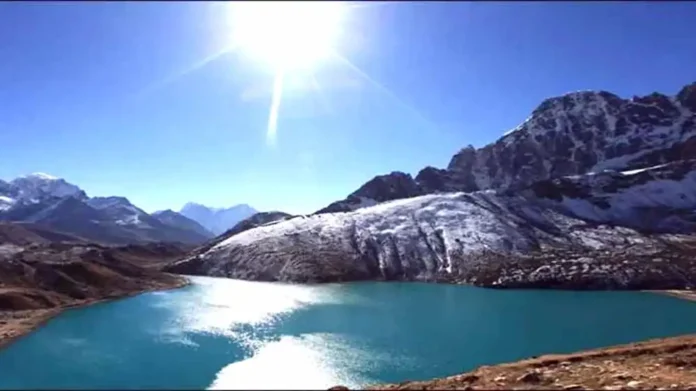A new study conducted by Nagaland University and Cotton University, Guwahati, has raised serious concerns about the retreat of glaciers in Arunachal Pradesh over the past three decades. The research, published in the renowned Journal of Earth System Science, highlights the impact of climate change on the fragile ecosystem of the Eastern Himalayas, which plays a crucial role in supplying freshwater to millions of people.
Himalayan Glaciers: The ‘Third Pole’ Under Threat
The Himalayas, often referred to as the ‘Third Pole’, hold the largest concentration of glaciers outside the polar regions. These glaciers are a critical water source for over 1.3 billion people living in India, China, Nepal, Bhutan, and Bangladesh. However, rising global temperatures and climate change have accelerated glacial melting, posing a severe threat to water security in the region.
Key Findings of the Study
The research, led by Dr. Latonglila Jamir from Nagaland University and Dr. Nabajit Hazarika from Cotton University, along with research scholars Vimha Ritse and Amenuo Susan Kulnu, utilized Remote Sensing (RS) and Geographic Information Systems (GIS) to analyze glacier retreat in Arunachal Pradesh between 1988 and 2020.
Glacier Loss Over the Past Three Decades
- In 1988, Arunachal Pradesh had 756 glaciers covering an area of 585.23 square kilometers.
- By 2020, the number of glaciers had dropped to 646, with a reduced area of 275.38 square kilometers.
- The average loss of glacial cover was 16.94 square kilometers per year.
The study also revealed that smaller glaciers—especially those covering less than 5 square kilometers—are retreating at a faster rate than larger ones.
Environmental and Water Security Implications
Dr. Latonglila Jamir, Associate Professor in the Department of Environmental Science at Nagaland University, explained that the retreat of glaciers in Arunachal Pradesh is not just an environmental concern but a major threat to communities that rely on glacial meltwater for agriculture and drinking water.
Short-Term vs. Long-Term Impacts
- Short-Term:
- Rapid glacial melting may initially lead to flooding and unstable river flows.
- Expansion of glacial lakes increases the risk of Glacial Lake Outburst Floods (GLOFs), which can cause catastrophic damage to downstream communities.
- Long-Term:
- As glaciers continue to shrink, water availability will decline, affecting agriculture, hydropower generation, and drinking water supplies.
- A reduction in glacial mass will disrupt the hydrological cycle, leading to drought-like conditions in certain regions.
Arunachal Pradesh and the Eastern Himalayas: A Less Studied Region
While glacier retreat has been widely studied in other parts of the Himalayas, research on the Eastern Himalayas, particularly in Arunachal Pradesh, remains limited. The region’s remote location and difficult terrain have made extensive studies challenging. However, this latest research provides critical insights into the climate change-driven transformations occurring in the Eastern Himalayan ecosystem.
Urgent Need for Climate Action and Conservation Efforts
The alarming rate of glacier loss in Arunachal Pradesh calls for immediate policy interventions to:
- Monitor Glacier Changes: Expand scientific research and satellite-based glacier monitoring in the Eastern Himalayas.
- Enhance Water Conservation Measures: Implement sustainable water management practices to prepare for potential water shortages.
- Reduce Carbon Emissions: Strengthen climate change mitigation strategies at national and global levels.
- Increase Disaster Preparedness: Develop early warning systems for Glacial Lake Outburst Floods (GLOFs) to protect vulnerable communities.
The retreat of glaciers in Arunachal Pradesh serves as a stark warning about the devastating impact of climate change on the Eastern Himalayas and the millions of people who depend on these glaciers for freshwater supply. The rapid loss of glacial cover is not only an environmental concern but also a socioeconomic crisis in the making, as it threatens agriculture, drinking water, hydropower generation, and overall ecosystem stability.
In the short term, accelerated glacier melting may cause flooding, unstable river flows, and glacial lake expansion, increasing the likelihood of Glacial Lake Outburst Floods (GLOFs)—a serious hazard for downstream communities. However, in the long term, as the glaciers continue to shrink, water availability will drastically decline, leading to droughts, food shortages, and economic disruptions in the region.
To mitigate these risks, immediate action is required at multiple levels:
- Scientific Research & Monitoring: More extensive remote sensing and GIS-based studies are needed to track glacier retreat and predict future water shortages.
- Sustainable Water Management: Governments must implement conservation strategies, such as rainwater harvesting, watershed management, and afforestation, to maintain water balance.
- Climate Change Mitigation: Global efforts to reduce carbon emissions, transition to renewable energy, and promote sustainable practices must be intensified to slow down glacial melt.
- Disaster Preparedness & Risk Reduction: Early warning systems, improved infrastructure, and emergency response plans must be developed to protect vulnerable communities from GLOFs and water shortages.
Addressing glacier retreat in Arunachal Pradesh requires urgent collaboration between scientists, policymakers, local communities, and international organizations. Without proactive intervention, the loss of Himalayan glaciers will have irreversible consequences for both environmental stability and human livelihoods. The time to act is now—before the water crisis in the Eastern Himalayas reaches a point of no return.



